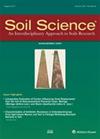Nutrient limitations regulate soil greenhouse gas fluxes from tropical forests: evidence from an ecosystem-scale nutrient manipulation experiment in Uganda
4区 农林科学
Q2 Agricultural and Biological Sciences
引用次数: 7
Abstract
Abstract. Soil macronutrient availability is one of the abiotic controls that alters the exchange of greenhouse gases (GHGs) between the soil and the atmosphere in tropical forests. However, evidence on the macronutrient regulation of soil GHG fluxes from central African tropical forests is still lacking, limiting our understanding of how these biomes could respond to potential future increases in nitrogen (N) and phosphorus (P) deposition. The aim of this study was to disentangle the regulation effect of soil nutrients on soil GHG fluxes from a Ugandan tropical forest reserve in the context of increasing N and P deposition. Therefore, a large-scale nutrient manipulation experiment (NME), based on 40 m×40 m plots with different nutrient addition treatments (N, P, N + P, and control), was established in the Budongo Central Forest Reserve. Soil carbon dioxide (CO2), methane (CH4), and nitrous oxide (N2O) fluxes were measured monthly, using permanently installed static chambers, for 14 months. Total soil CO2 fluxes were partitioned into autotrophic and heterotrophic components through a root trenching treatment. In addition, soil temperature, soil water content, and nitrates were measured in parallel to GHG fluxes. N addition (N and N + P) resulted in significantly higher N2O fluxes in the transitory phase (0–28 d after fertilization; p<0.01) because N fertilization likely increased soil N beyond the microbial immobilization and plant nutritional demands, leaving the excess to be nitrified or denitrified. Prolonged N fertilization, however, did not elicit a significant response in background (measured more than 28 d after fertilization) N2O fluxes. P fertilization marginally and significantly increased transitory (p=0.05) and background (p=0.01) CH4 consumption, probably because it enhanced methanotrophic activity. The addition of N and P (N + P) resulted in larger CO2 fluxes in the transitory phase (p=0.01), suggesting a possible co-limitation of both N and P on soil respiration. Heterotrophic (microbial) CO2 effluxes were significantly higher than the autotrophic (root) CO2 effluxes (p<0.01) across all treatment plots, with microbes contributing about two-thirds of the total soil CO2 effluxes. However, neither heterotrophic nor autotrophic respiration significantly differed between treatments. The results from this study suggest that the feedback of tropical forests to the global soil GHG budget could be disproportionately altered by increases in N and P availability over these biomes.营养限制调节来自热带森林的土壤温室气体通量:来自乌干达生态系统规模的营养操纵实验的证据
摘要土壤宏量养分有效性是改变热带森林土壤与大气之间温室气体交换的非生物控制因素之一。然而,关于中非热带森林土壤温室气体通量的巨量养分调节的证据仍然缺乏,这限制了我们对这些生物群落如何应对未来氮(N)和磷(P)沉积可能增加的理解。本研究的目的是在氮磷沉降增加的背景下,解开乌干达热带森林保护区土壤养分对土壤温室气体通量的调节作用。为此,在布东戈中央森林保护区40个m×40 m样地进行了不同营养添加处理(N、P、N + P和对照)的大规模养分操纵试验(NME)。土壤二氧化碳(CO2)、甲烷(CH4)和氧化亚氮(N2O)通量每月测量一次,使用永久安装的静态室,持续14个月。通过根化处理,将土壤总CO2通量划分为自养和异养组分。此外,土壤温度、土壤含水量和硝酸盐与温室气体通量并行测量。施氮(N和N + P)显著提高了过渡阶段(施肥后0 ~ 28 d)的N2O通量;p<0.01),因为氮肥可能使土壤氮的增加超出了微生物固定和植物营养需求,使多余的氮被硝化或反硝化。然而,延长施氮时间对背景氮通量(施氮后超过28 d)没有显著影响。施磷肥对瞬时(P =0.05)和本底(P =0.01)CH4消耗有微弱而显著的促进作用,可能是由于施磷肥增强了甲烷营养活性。N和P (N + P)的添加导致暂态CO2通量增大(P =0.01),表明N和P可能共同限制土壤呼吸。各处理区异养(微生物)CO2外排显著高于自养(根)CO2外排(p<0.01),微生物贡献了约三分之二的土壤CO2外排。然而,在不同处理之间,异养呼吸和自养呼吸均无显著差异。本研究的结果表明,热带森林对全球土壤温室气体收支的反馈可能会因这些生物群落N和p有效性的增加而发生不成比例的改变。
本文章由计算机程序翻译,如有差异,请以英文原文为准。
求助全文
约1分钟内获得全文
求助全文
来源期刊

Soil Science
农林科学-土壤科学
CiteScore
2.70
自引率
0.00%
发文量
0
审稿时长
4.4 months
期刊介绍:
Cessation.Soil Science satisfies the professional needs of all scientists and laboratory personnel involved in soil and plant research by publishing primary research reports and critical reviews of basic and applied soil science, especially as it relates to soil and plant studies and general environmental soil science.
Each month, Soil Science presents authoritative research articles from an impressive array of discipline: soil chemistry and biochemistry, physics, fertility and nutrition, soil genesis and morphology, soil microbiology and mineralogy. Of immediate relevance to soil scientists-both industrial and academic-this unique publication also has long-range value for agronomists and environmental scientists.
 求助内容:
求助内容: 应助结果提醒方式:
应助结果提醒方式:


